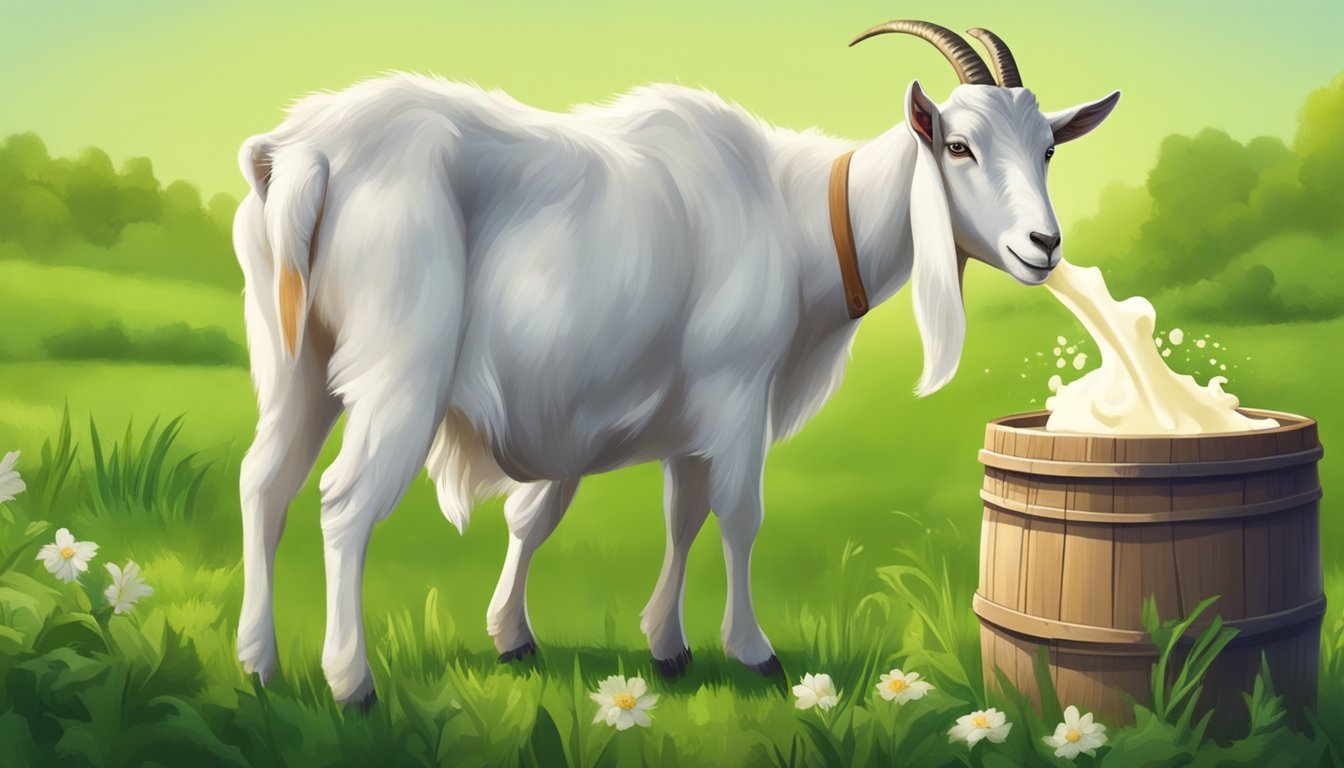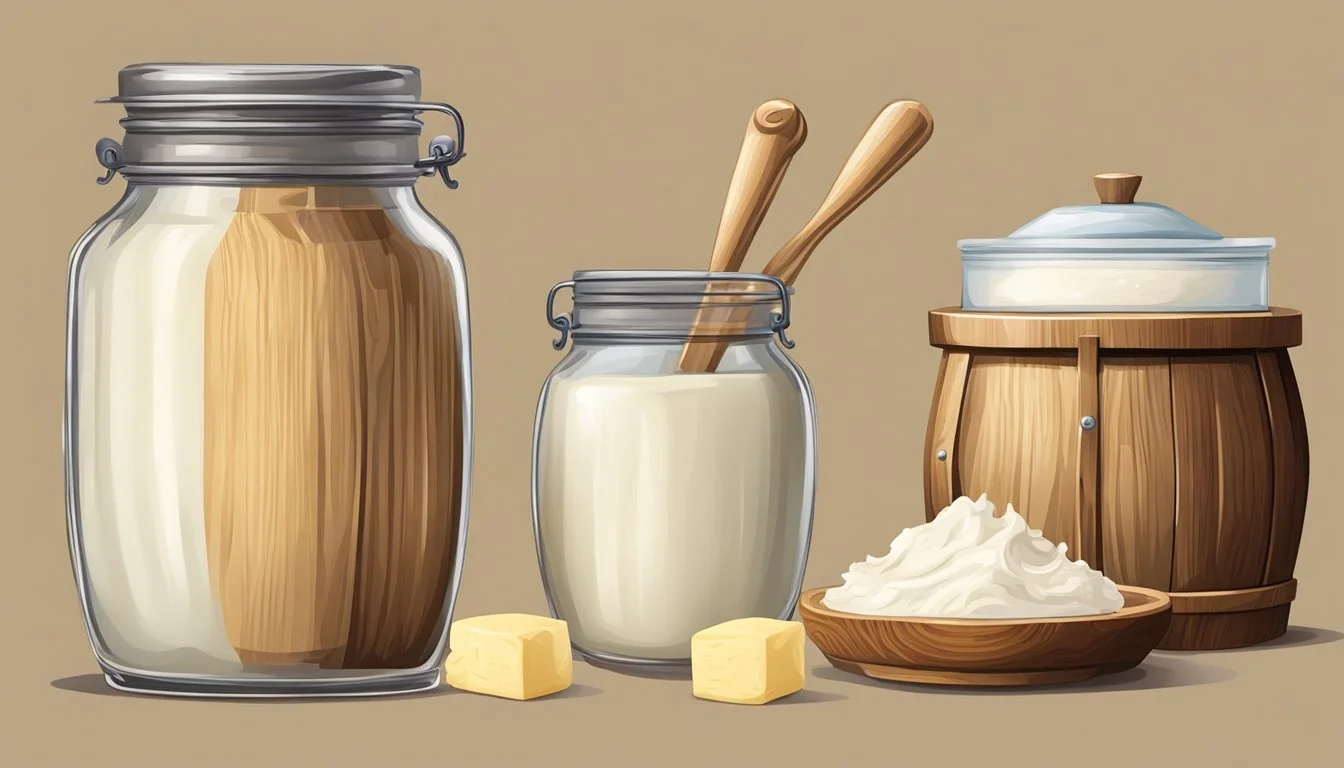The Art of Crafting Goat Milk Butter
Your Ultimate Homemade Dairy Delight
Crafting butter from goat milk is a practice steeped in tradition, offering a delectable alternative to butter made from cow's milk. This butter is prized for its unique, tangy flavor and creamy texture, and can be made at home with a few essential ingredients and tools. The process begins with fresh goat milk, known for its numerous health benefits and richer consistency. Freshness is key, as it dictates the quality and flavor of the final product.
Separating the cream from goat milk is the first critical step in making butter. Unlike cow's milk, goat milk requires more time for the cream to rise to the top; thus, patience is necessary. Once the cream is obtained, it should be placed in the refrigerator to chill. Chilling helps in solidifying the fats, which is crucial for the churning process that follows.
With chilled cream at hand, attention to detail and timing become paramount in achieving the right consistency for goat milk butter. Using clean, chilled equipment aids in whipping the cream into butter, with the process gently separating the butterfat from the buttermilk. While the ingredient list is simplistic, the artistry lies in the transformation of liquid cream into a spreadable, flavorful butter that enriches any culinary creation it accompanies.
Understanding Goat Milk and Its Benefits
Goat milk is gaining popularity as an alternative to cow milk due to its nutritional profile and its digestibility. People who consume fresh goat milk frequently tout its potential health benefits. Unlike cow's milk, goat milk has smaller fat globules, which may make it easier to digest.
The composition of goat milk includes essential fatty acids that are vital for overall health. These fatty acids contribute to the creaminess of goat butter and play a role in maintaining heart and brain health.
Calcium is another key nutrient found in goat milk, contributing to bone strength and overall skeletal health. Many consumers seek goat milk for its high-quality protein, as well as the presence of minerals and vitamins, such as vitamin D and potassium.
Here is a brief overview of goat milk's benefits:
Digestibility: Smaller fat globules and a different protein structure may aid digestion.
Nutrient-Rich: It provides a good source of calcium, protein, and essential fatty acids.
Hypoallergenic: May be a good option for those sensitive to cow's milk.
Some prefer raw milk from goats due to its minimal processing. However, it's important to source raw milk from reputable farms to ensure safety and quality.
In summary, goat milk is a valuable ingredient for both direct consumption and for making wholesome products like goat milk butter.
Equipment and Ingredients for Butter Making
In the process of making goat milk butter, one’s success heavily relies on both the proper equipment and high-quality ingredients. This section will guide you through the vital tools and components needed to craft delicious butter from goat milk.
Essential Butter-Making Tools
For the butter-making adventure, certain tools are indispensable to achieve the desired outcome. One will require:
Mixer: Ideal for churning cream into butter, be it a KitchenAid mixer or another brand.
Cream Separator: Separate the cream from milk with ease using a reliable cream separator.
Blender/Food Processor: Alternatives that can be used if a mixer is not available. They must have a high-speed setting to properly agitate the fat molecules.
Cheesecloth or Separator: Essential for straining and purifying the butter.
Ensure all equipment is clean and sterile before use to prevent any contamination.
Choosing Quality Ingredients
The quality of butter is largely influenced by the ingredients used. When selecting ingredients, one should consider:
High-quality Goat Milk: Fresh and possibly raw to ensure the highest fat content, which is crucial for butter production.
Herbs, Spices, and Salt: Incorporate garlic, fresh herbs, or spices to infuse the butter with unique flavors. Use coarse or flaked sea salt for an enhanced taste and texture.
A precise balance of these ingredients will culminate in rich and flavorful goat milk butter, showcasing the natural goodness of the milk complemented by the chosen herbs and spices.
Preparation Steps Before Churning
Prior to churning goat milk into butter, one must carefully prepare the milk through separation and skimming, as well as ensure that all equipment used is thoroughly sanitized. These steps are critical to achieving high-quality goat milk butter.
Milk Separation and Skimming
One begins by collecting raw goat milk directly into an airtight container, making sure that the container is clean to prevent contamination. The temperature at which the milk is stored is pivotal; it should be kept cool to prevent spoilage. To separate the cream needed for butter, one can employ a cream separator or allow for gravity separation over time, which involves the cream naturally rising to the top. Following separation, skimming off the cream is performed with great care to preserve its richness. This cream will be the base of the butter.
Gravity Separation Method:
Collect raw goat milk into a container.
Store at a cool temperature for approximately 12-24 hours.
Skim off the cream that has risen to the top.
Cream Separator Method:
Utilize a machine to expedite cream separation from the milk.
Sanitization and Ensuring Cleanliness
Proper sanitization of equipment cannot be overstated—everything that comes into contact with the milk or cream must be impeccably clean. This includes the containers, cream separator, skimming tools, and any other utensils. One should wash these items with hot, soapy water and, if needed, a specified sanitizer. Additionally, when handling pasteurization, if desired, the process must be executed correctly to maintain the safety of the raw goat milk without compromising its natural qualities. Utmost care in this preparation phase lays the groundwork for the highest quality goat milk butter.
The Churning Process
Creating goat milk butter involves a precise churning process where butterfat is separated from the buttermilk. Mastery of temperature control and an understanding of the texture changes are crucial for crafting creamy, high-quality butter.
Cream Churning Techniques
The objective of churning is to agitate the fat globules in the cream until they coalesce into butter. This is traditionally done using a butter churn, a device consisting of a container with a paddle attached to a handle. The churning action needs to be steady and consistent, and can take various durations based on several factors, including the initial temperature of the cream.
Manual Churning: This involves turning the handle connected to the paddle inside the churn. One needs to maintain a steady rhythm to effectively combine the fat globules.
Electric Churning: For those who prefer a more modern technique, electric butter churners are available that automate the churning process, ensuring uniform agitation and reducing manual labor.
Monitoring Temperature and Texture
Temperature: Correct temperature control is a vital aspect of making butter. The cream should ideally be churned at temperatures between 55-60°F (13-16°C). To measure this, a dairy thermometer is used. The consistency of temperature ensures that the butterfat solidifies at the right rate, contributing to the butter's final creamy texture.
Texture: As churning progresses, the texture of the mixture will shift through several stages. First, it will become thick and whipped-cream-like, then grainy as the fat globules begin to fuse, and finally, it separates into solid butter and liquid buttermilk. Monitoring this transition is important to determine when to stop churning. One needs to watch for when the solid mass of butter begins to form, signifying the end of the churning phase.
Post-Churning Procedures
After the churning process is complete, it is essential to wash and knead the butter to ensure proper texture and flavor. These post-churning steps are critical for achieving the creamy consistency and taste that make homemade goat milk butter a delight.
Washing the Butter
Immediately following butter separation, washing the butter is critical. This step removes any lingering buttermilk, which can spoil the butter. Here's a simple method to wash the butter:
Place the butter in a clean bowl with cold water.
Gently press the butter with a spoon or spatula to expel excess water.
Drain and repeat until water runs clear.
This process preserves the butter's texture, ensuring it remains creamy and extends its shelf life.
Kneading and Flavoring
Once the butter is washed, kneading is the next vital step. Kneading helps to further expel water, and it's during this stage that one can add flavors to the butter. For example:
Sprinkle sea salt for a classic taste.
Mix in a pinch of garlic powder or onion powder for a savory kick.
Incorporate finely chopped herbs for an aromatic twist.
Carefully work these additions into the butter to evenly distribute the flavor. Once kneaded to a smooth consistency, the butter is ready to be shaped and stored.
Storing and Preservation
Proper storage is crucial for maintaining the freshness and flavor of goat milk butter. Following the right techniques ensures extended shelf life and optimal quality.
Airtight Storage
Butter absorbs flavors, so an airtight container is essential to preserve its delicate taste. Such containers also prevent oxidation. For best results, one should wrap the goat milk butter in parchment paper before placing it in the container, then store it in the coolest part of the refrigerator.
Freezing and Refrigeration Tips
For long-term storage, freezing is an effective method. Wrap the butter in aluminum foil or freezer-specific wrap, then place it in a freezer bag before storing it in the freezer. When thawing, transferring the butter to the refrigerator for several hours ensures a gradual return to its creamy texture. The typical shelf life of goat milk butter is up to three weeks in the refrigerator, but it can last up to six months in the freezer if stored properly.
Incorporating Goat Milk Butter in Various Dishes
When it comes to enriching your culinary creations, goat milk butter stands out for its unique flavor profile and creamy texture. Chefs often substitute goat milk butter in traditional recipes to add a hint of tanginess. It can be especially delightful when spread over warm, artisanal bread or melted into a bowl of steaming oatmeal.
In savory dishes, goat milk butter serves as an excellent base for sautéing vegetables, elevating their natural flavors. It is also well-suited for frying due to its higher melting point, making it a reliable choice for creating crispy, golden-brown finishes on proteins like chicken or fish.
Here is how one might incorporate homemade goat milk butter into various dishes:
Breakfast: As a spread on pancakes, waffles, or muffins
Lunch: Melted into creamy soups or pasta sauces
Dinner: For basting meats or finishing off a rich gravy
Dessert: In pastries or as a complement to fruit-based desserts (What wine goes well with fruit-based desserts?)
Experimenting with goat milk butter in baking can also yield delightful results. Its unique flavor can enhance the richness of cakes, cookies, and pie crusts, giving a new twist to beloved desserts.
Remember, homemade butter carries the satisfaction of crafting something delightful in one's own kitchen. For those who are lactose intolerant, goat milk butter is often a more digestible alternative to cow's milk butter. Adding it to one's recipes enhances both the taste and the nutritional value of meals given its beneficial fatty acids and vitamins.
Understanding and Troubleshooting Common Issues
Crafting goat milk butter requires attention to detail and an understanding of potential pitfalls. This section aims to tackle two common issues in the butter-making process, guiding the reader through the steps of separating cream from milk and addressing the challenges of impurities.
Separating Cream from Milk
Separating cream from goat milk is crucial for butter production. The cream is where the butterfat resides, and not properly separating it can lead to low yields. First, ensure that the milk is fresh; aged milk may not separate well. Then, let the milk sit refrigerated for 12 to 24 hours to allow the cream to rise to the top. To aid this natural process, one might consider using a cream separator, which can efficiently spin the milk and separate the cream based on density. If the cream is not separating as expected, it might be worth examining the milk's temperature and the pasteurization process, as these can influence the separation.
Checklist for Effective Cream Separation:
Ensure milk freshness.
Refrigerate milk for 12-24 hours.
Verify the temperature, which should be consistent and cold.
Dealing with Impurities
Impurities such as dirt and debris can inadvertently find their way into milk and hence into the butter if not properly handled. Filtration is an early step that should not be overlooked. Filtering the milk before the pasteurization process can remove most visible impurities. Use fine mesh strainers or cheesecloth to catch these particles. If impurities persist, the cause might be environmental, and it would be imperative to inspect and clean the milking equipment and storage containers. In some cases, additional filtering after pasteurization might be necessary to achieve the purity needed for high-quality butter.
Strategies to Address Impurities:
Filter milk with fine mesh or cheesecloth before and, if needed, after pasteurization.
Regularly clean all equipment and storage containers.
By adhering to these specific troubleshooting tips, artisans can improve the quality of their goat milk butter and enjoy a more successful and satisfying experience.
Enjoying Your Homemade Goat Milk Butter
Once you've crafted your homemade goat milk butter, you'll find it offers a unique, creamy taste that can enhance a variety of dishes. This section explores creative ways to utilize your homemade butter and provides practical advice to ensure you savor every moment of your goat butter experience.
Creative Uses for Goat Butter
Cooking: Homemade goat milk butter can transform an ordinary meal into a gourmet experience. It can be used in sautéing and frying, adding a rich depth to dishes.
Baking: Its unique flavor makes it a delightful substitute in baked goods. Give an extra twist to pastries, like croissants or cookies, for a distinctive, mouthwatering treat.
Spreading: It's perfect for spreading on artisan breads, bagels, and muffins. The richness of the butter pairs exceptionally with the rustic textures of whole grains.
Flavoring Enhancements: Infuse your goat butter with herbs, spices, or edible flowers to create custom flavorings that can elevate any dish.
Tips for Maximum Enjoyment
Storing for Freshness: To preserve its flavor and quality, store your goat milk butter in an airtight container in the refrigerator. For long-term storage, freezing in small portions ensures you can enjoy it for months.
Serving Temperature: Serve your homemade goat butter at room temperature to ensure its texture is perfectly spreadable and its flavors are at their peak.
Pairing with Foods: To appreciate its subtle taste, pair it with foods that don't overpower its flavor. Fresh bread, plain rice, or steamed vegetables make excellent companions.
Experiment with Recipes: Don't hesitate to experiment by using your homemade goat butter in place of cow's milk butter in recipes. It might just be the secret ingredient you've been looking for!
By following these tips and tricks and exploring creative uses, you can fully enjoy the fruits of your labor and impress others with the versatile and delightful flavors of your homemade goat milk butter.
Health and Nutritional Information
Goat milk butter is a high-quality dairy product known for its unique nutritional composition and health benefits. It provides key nutrients essential to maintaining a healthy diet.
Nutritional Profile of Goat Milk Butter
Goat milk butter is recognized for its richness in fatty acids and essential nutrients. Typically, it contains:
Vitamins: A, D, E, and K
Minerals: High levels of calcium, phosphorus, and magnesium
Beneficial fatty acids: Such as capric, caprylic, and caproic acid
This butter is also characterized by the presence of medium-chain triglycerides (MCTs), which are fats with potential health benefits such as supporting metabolism.
Comparative Health Benefits
When compared to butter made from cow's milk, goat milk butter offers several distinctive health advantages:
Digestibility: The fat molecules in goat milk butter are smaller, which can ease digestion for some individuals.
Alpine goats' milk: This variety often provides milk that is considered to be of higher nutritional quality, including elevated levels of fatty acids and minerals.
Bacterial growth: Goat milk butter typically has a different bacterial profile that may contribute to unique flavors and potentially beneficial effects on gut health.
Remember, while goat milk butter can be a beneficial addition to your diet, it should be consumed in moderation as part of a balanced diet.
Ethical and Environmental Considerations
Crafting goat milk butter involves more than following a recipe; it incorporates a conscious decision-making process regarding the ethical sourcing of ingredients and understanding the impact on the environment.
Sourcing Ethical Ingredients
Ethical sourcing prioritizes the well-being of animals and the fairness of labor practices. For butter production, this means choosing goat milk from farms that ensure goats are treated humanely, with ample space and proper nutrition, steering clear of unnecessary additives or preservatives. Producers are encouraged to collaborate with farms that transparently confirm their adherence to animal welfare standards.
Impact on the Environment
The process of butter making, specifically gravity separation, has a minor environmental footprint compared to mechanical methods, as it utilizes the natural settling of cream without additional energy consumption. However, the dairy industry, in general, contributes to greenhouse gas emissions—a fact that cannot be overlooked. Dairy producers must be vigilant against harmful bacteria to avoid the use of excessive anti-microbial agents, which can be detrimental to both health and the environment. Producers can reduce environmental impact by adopting practices such as recycling water, using renewable energy sources, and minimizing waste.








